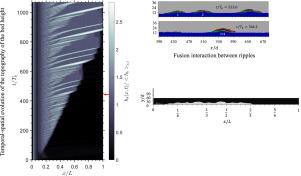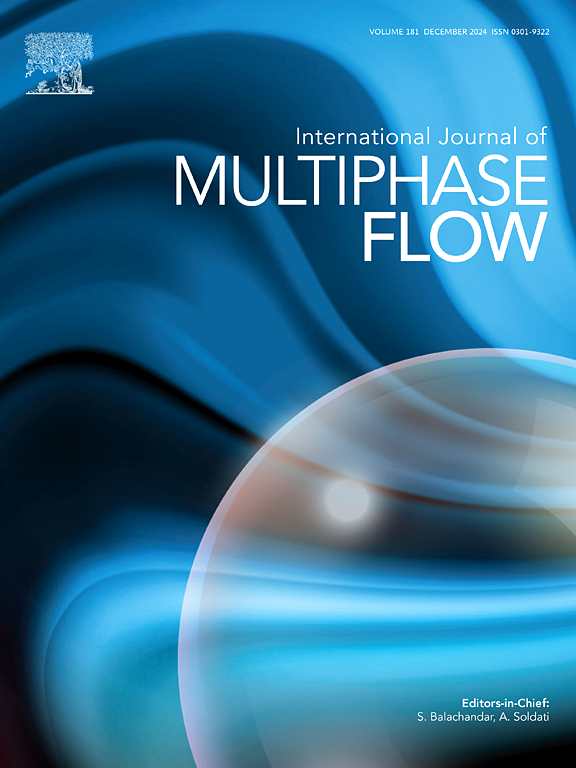基于欧拉-拉格朗日方法的低流速水平风管输运颗粒沉积物河床形态演化数值模拟
IF 3.8
2区 工程技术
Q1 MECHANICS
International Journal of Multiphase Flow
Pub Date : 2025-09-26
DOI:10.1016/j.ijmultiphaseflow.2025.105463
引用次数: 0
摘要
利用欧拉-拉格朗日方法,我们数值研究了颗粒颗粒在水平管道中低流速输运过程中泥沙模式的形成。在入口处引入的颗粒沉积物在入口附近形成一个上升的河床,并在下游过渡为水平段。最初的波纹是在靠近入口的倾斜河床上逐渐形成的,然后依次坍塌,最终形成一个更大的河床,在波纹序列的下游发育。这种较大的床型在下伏的水平床段上独立地向下游传播。增加流量、管道的高度或宽度,或引入向下的管道倾角,可促进整个管道长度的床层平坦化。这减少了波纹和床型之间的区别,有利于更均匀的床型。我们的观察揭示了从波纹阵列到河床的粗化过程中,三种不同类型的波纹相互作用:分裂、融合和母波纹下游小沙袋的形成。我们量化了图案特征,包括周期、波长、迁移速度和粒子输运率作为屏蔽数的函数。值得注意的是,粒子传输速率——无论是从单个模式还是从纹波阵列的蠕动中得出的——始终遵循Meyer-Peter和m本文章由计算机程序翻译,如有差异,请以英文原文为准。

Numerical simulation of bedform evolution on granular sediment beds via Eulerian–Lagrangian approach in low-flow-rate horizontal duct transport
Using an Eulerian–Lagrangian approach, we numerically investigate sediment pattern formation during low-flow-rate transport of granular particles in a horizontal duct. Particles introduced at the inlet sediment to form a rising bed near the entrance, which transitions into a horizontal section further downstream. Incipient ripples emerge progressively based on the inclined bed near the inlet, then successively collapse, ultimately giving way to a larger bedform that develops downstream of the ripple sequences. This larger bedform propagates independently downstream over the underlying horizontal bed section. Increasing the flow rate, duct’s height or width, or introducing downward duct inclination promotes bed flattening along the entire duct length. This reduces the distinction between ripples and bedforms, favoring more uniform bed patterns. Our observations reveal three different types of ripple interaction during the coarsening process from ripple array to bedform: splitting, fusion, and the formation of a small sandbag downstream of the parent ripple. We quantify pattern characteristics, including period, wavelength, migration velocity, and particle transport rate as functions of the Shields number. Notably, particle transport rates — whether derived from individual patterns or from creeping of the ripple array — consistently follow the power-law relationship established by Meyer-Peter and Müller. Furthermore, we analyze the morphology of the bed profile in the inclined section near the entrance of the conduct based on the skin friction of the bed surface, as well as the distributions of boundary shear stress along the interface of an individual bedform. For the bedforms with the downstream bed higher than the upstream, the surface shear stress profiles along the bedforms show a distinct downward-pointing cusp near the trough. This feature is analogous to the stress pattern observed upstream of a bump.
求助全文
通过发布文献求助,成功后即可免费获取论文全文。
去求助
来源期刊
CiteScore
7.30
自引率
10.50%
发文量
244
审稿时长
4 months
期刊介绍:
The International Journal of Multiphase Flow publishes analytical, numerical and experimental articles of lasting interest. The scope of the journal includes all aspects of mass, momentum and energy exchange phenomena among different phases such as occur in disperse flows, gas–liquid and liquid–liquid flows, flows in porous media, boiling, granular flows and others.
The journal publishes full papers, brief communications and conference announcements.

 求助内容:
求助内容: 应助结果提醒方式:
应助结果提醒方式:


